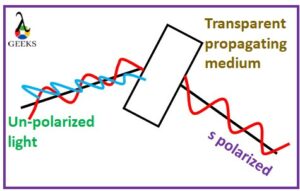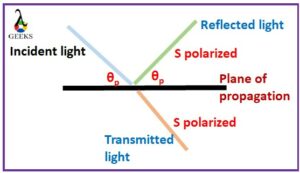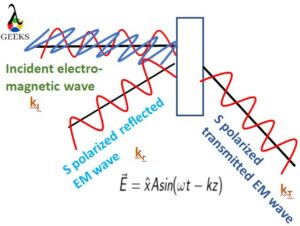Polarization is the process of aligning the unpolarized electromagnetic wave in one direction. This process of alignment into a single direction corresponds to the nature of the incident wave on the medium.
Based on the nature of the incident wave striking the medium, the polarization of the wave can be said to s polarized or not. The propagation of an s polarized wave is the same as the normal polarized wave, but the incidence of the wave on the medium makes the wave classified as s-polarized. A brief introduction to s-polarized waves is discussed in this post.
What is s polarized light?
If a shattered electromagnetic wave, say the light wave, is made to transmit through a plane medium, the light is confined into a single direction.

When the incident light is in the direction perpendicular to the plane of propagating medium, and then it confines the light wave to achieve a single direction of propagation, such a polarization of light is called s polarized light.

Suppose an unpolarized light wave is an incident on a dielectric medium; after transmitting in the medium, the incident light wave traces a well-defined path in a single direction, causing the polarization if the polarization takes place perpendicular to the medium the polarization nothing but s polarization.
The light which has to be s polarized should be perpendicular to the plane of incidence and parallel to the interference.
If the incident light is monochromatic, the state of polarization of light involves the non-zeros components at the planar interface generates the field in the rarer medium whose polarization will be elliptical.
s-polarized light reflection
When the light gets polarized, not all the waves of light are transmitted through the medium. Some of the light waves may be reflected by the plane medium.
The reflection of s polarized light depends on Brewster’s angle as the incident angle. The s polarized light undergoes total internal reflection (TIR) at a dielectric interface at the angle of incidence ψ. Since at Brewster’s angle, no reflection takes place, the angle of incidence must be less or greater than Brewster’s angle.
For expected propagation of incident light perpendicular to the interface of the medium, the s polarized light shows reflectivity. The s polarized light component is not perpendicular to the electric field components; thus, light propagating with Brewster’s angle must undergo total internal reflection.
Gauss law states that “the electric field must be continuous except in the presence of charge.” But for s polarized light, the electric field in the incident and transmitted layers is not equal. Thus electric field shows discontinuity, so there will be the reflection of s polarized light due to the exhibiting the different amplitudes of the electric field in the transmission medium.

The formula can give the angle of reflection of s polarized light
tanθp=n2/n1
Where θp is the reflected angle and n1, and n2 is the refractive indices of the medium, since the transmission of polarized light is taking place from one medium to another medium.
The equation can also be written as
sinθp/cosθp=n2/n1
Since the above equation is similar to Snell’s law, it can be rewritten as
sinθp/sinr=n2/n1
Because cos θp = sin r, the angle of reflection. Thus we get the equation as
sin π/2-θp=sinr
θp+r= π/2
The above equation gives the reflection of the s polarized light.
s-polarized incident light
If the linear polarization of incident light itself s polarized then the polarized, then there will be the complete transmission of the light through the medium.
When the s polarized light is incident on the dielectric medium, the refraction of the polarized light can be observed. The incident light refracts into two beams. One refracted beam is oriented parallel to the transmission medium, and another one is perpendicular to the transmission medium.
Thus we can use the polarized filter to block the two refracted rays to produce the image. The light is entirely blocked by the polarized filter producing the bright image of the perpendicular component, and the second image will appear when the filter is turned 90°.
s polarized wave
The term polarization is possible only in electromagnetic waves and radio waves. Since, in the case of an electromagnetic wave, the electric field and the magnetic field are oriented in different directions perpendicularly, the polarization can be easily monitored.

In this section, let us learn what is s polarized wave and the nature of s polarized wave.
What is s polarized wave?
Since we are talking about the wave, we will consider the electromagnetic wave because the electromagnetic wave is an excellent example of the transverse wave. The electromagnetic wave incident on the medium is confined into a single direction, i.e., both electric field and magnetic field, causing the polarization.
If the electromagnetic field hits the medium and it begins transverse perpendicular to the plane of incidence, then the wave is said to be s polarized wave. The amplitude of the wave increases with the angle of incidence increases in the s polarized wave.
Suppose an electromagnetic wave of E and B field is incident on the plane medium, a part of the wave is transmitted, and a part of the wave is reflected in the same medium as shown in the figure.
The electric field vector for the above oscillation of the electric field is given by
E→=x→ A sin (wt – kz)
Where; A is the amplitude of the wave and k is the propagation vector.
The electric field vector is perpendicular to the plane of incidence; thus, the polarized wave is called an s polarized wave. The propagation vector has three components KI, Kr, KT; these are the propagation vectors of the angle of incidence, reflection and transmission of the s polarized wave.
s-polarized dipole
When a minimal distance holds two equal and opposite charges, the arrangement is called a dipole. Suppose a dielectric material is kept on an electric field; the field induces the electric dipole and holds them in the direction of the field. The external electric field is also involved in the process of aligning the electric dipole in the field direction; this entire process is called dipole polarization.
When the electric dipole induced by the field is perpendicular to the plane of propagation, then the polarization is known as s polarized dipole. In this case, polarizability, the negatively charged particles are slightly moved away from the positively charged particle so that the molecule acquires an electric dipole moment.
Frequently Asked Questions
Does s polarized lights are linearly polarized?
The light is linearly polarized when the electric field of light is restricted to propagate in a single direction along the plane of propagation.
If the s polarized light is allowed to move only in the direction of propagation without the phase shift, then the s polarized lights are said to be linearly polarized. Generally, if the incident light wave and the transmitted light waves are in phase, perpendicular to the propagation plane are linearly s polarized light.
Can we get circularly s polarized light?
The circularly polarized lights have the 90° phase shift with the incident light-medium.
If the polarized light is out of phase at 90° and propagates normal to the plane of incidence, then we get the circularly polarized light as a component of s polarized light. The magnitude and the amplitude of the polarized light are equal with the incident light; only there will be a shift in the phase of the polarized light.
Does laser beams are polarized?
Most of the laser beams are polarized, but some of the lasers are un-polarized. It depends on the nature of designing the optics of the laser source.
Laser beams are confined to a single direction and are coherent. Point them on the white paper in a dark room if you have a laser. Rotate the paper; if the brightness of the laser spot changes, then the laser source is partially polarized. If the brightness remains the same, the laser beams are almost polarized. It isn’t easy to achieve an utterly polarized laser.
Can we achieve complete transmission of incident light by polarization?
Due to some surface phenomena, the complete transmission of incident light through polarization is hard to achieve.
Polarization refers to holding up randomly distributed light waves in one single direction. The confinement of all the light rays which strikes the medium is not possible becomes some of the light rays may get reflected from the medium before they get confined.
What are the methods used for polarizing the light?
Generally, there are four methods used to polarize the unpolarized light, which used a specific medium to execute their action; they are
- Polarization by Polaroid filters -uses particular dichroic material that absorbs the unwanted unpolarized lightwave and transmits only the suitable light rays.
- Polarization by reflection –they use the non-metallic medium to prevent un-polarized light propagation from confining them.
- Polarization by refraction – they use two material mediums of different refractive indices for polarizing the shattered light.
- Polarization by scattering – involves the propagation of un-polarized light to travel on through a medium that can absorb and reemit light.
Also Read:
- Parallel polarization
- Is ch2cl2 polar
- Is sif4 polar or nonpolar
- Is tetrahedral polar
- So2 polar or nonpolar
- P polarized
- S polarized vs p polarized
- Perpendicular polarization
I am Keerthi K Murthy, I have completed post graduation in Physics, with the specialization in the field of solid state physics. I have always consider physics as a fundamental subject which is connected to our daily life. Being a science student I enjoy exploring new things in physics. As a writer my goal is to reach the readers with the simplified manner through my articles.